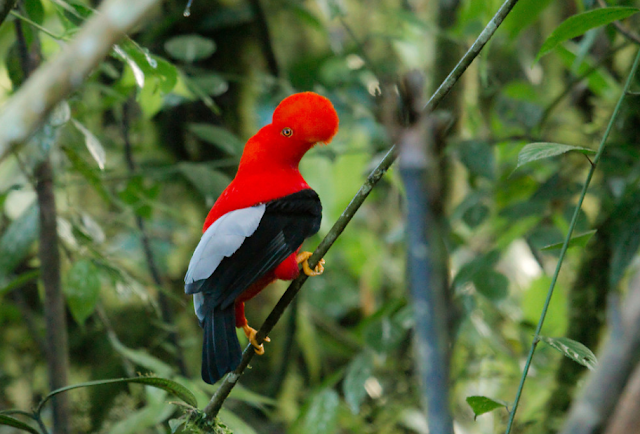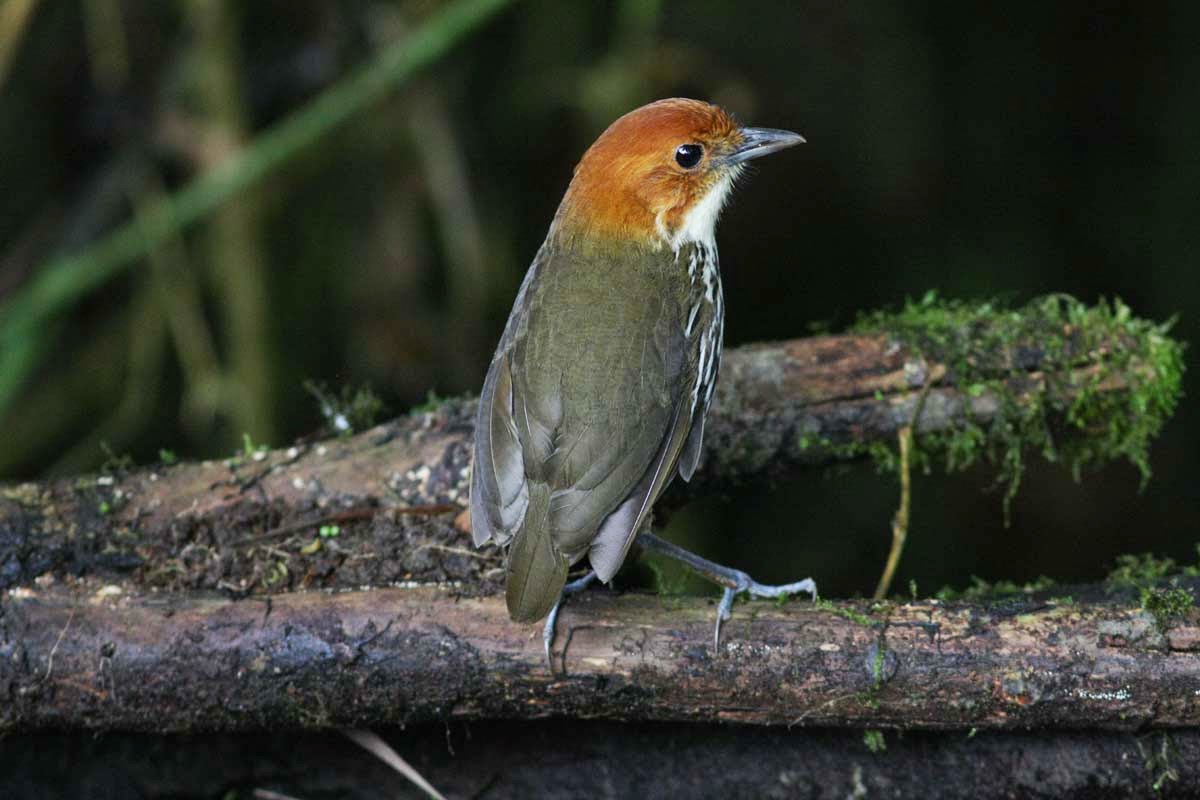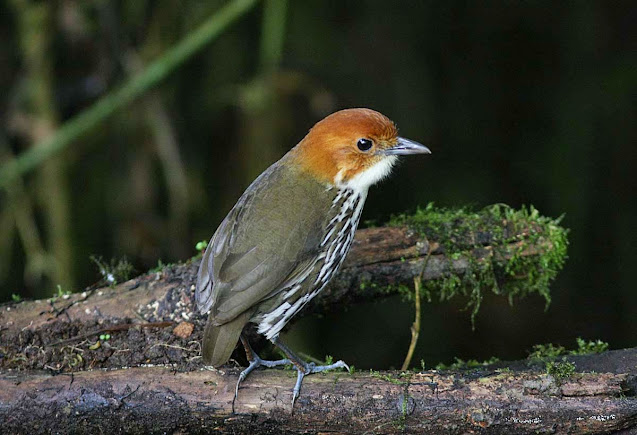11th October 2014
Refugio Paz de las Aves
It rained hard all night. In my subconcious I sensed it beating down on the terrace outside my window and waking in the early hours I found it was still raining. I was depressed as rain would caste a huge shadow on a day I had eagerly anticipated for months. Still, there was nothing I could do about it except remain philosophical. I woke at 4.30 after my troubled night's sleep and listened. All was quiet, no thrumming of rain on the roof or terrace outside. It had been raining non stop, heavy tropical rain, for eleven hours but it had finally stopped and my spirits lifted. Today we were to make an earlier than normal start to get to Angel Paz's reserve at first light. No breakfast, just a quick cup of tea. The Americans were already up and ready to go with their guide.
It was still dark, damp and wet underfoot as I opened the glass door of the Las Gralarias Centre. The door was a quilt of moths, literally festooned with hundreds of insects of huge shapes and sizes attracted by the outside light. I tried not to dislodge any of them, leaving them comatose and clinging to the glass.
Rolando who lives nearby in another village was already waiting for us and we piled into the pickup and headed back down the long bumpy road, crossing back over the Equator into the southern hemisphere again and back onto the main road for the half hour drive to Refugio Paz de las Aves.
The Refugio which is two hours drive northwest of Quito was started by two brothers Angel and Rodrigo Paz in 2005 and has since become world famous as the place to see antpittas. Originally poor farmers they realised by chance that they could make a living from creating a reserve on their land where birders and tourists could come and see antpittas and the spectacular Andean Cock of the Rock lek. They charged $10.00 (what a farmer would earn in a day) for a four hour visit and have gone from strength to strength. Angel and Rodrigo have schooled, over many months, the various antpittas inhabiting the forest to come to their call, the birds knowing they will be rewarded with some cut up worms. The antpittas are by no means tame but have been conditioned to respond by habit so they will show up, often only briefly, to the delight of birders and tourists from all over the world. You can read more about these remarkable men on their web site www.refugiopazdelasaves.com.
 |
| Angel Paz |
 |
| Dusan with Rodrigo and Angel Paz |
We arrived in a grey dawn with low cloud, the vegetation still dripping from the previous night's rain and the ground sodden and muddy. There were about ten of us in all and Angel told us that first he would show us his latest antpitta triumph - a Scaled Antpitta . He walked up the road fifty or so metres and started calling. The light was still dull and I could see nothing moving but then a brown bird dropped from the high bank of vegetation on his left and hopped around by the side of the road before grabbing a couple of the distributed worms and flying back into cover on the other side of the road. It did not re-appear. Oh well let's hope it is not all like this. Angel was apologetic telling us this bird is still quite nervous and it will take another few months before it is confident enough to show itself properly.
We walked up the rising track and turned right into the forest and followed a slippery, leaf sodden track with the usual obstacles of roots and branches for the unwary to negotiate. No one fell and no one slipped as we gingerly followed Angel. I could hear loud raucous shrieks and gurgling noises coming from the trees ahead of us. 'Cock of the Rocks' Dusan whispered to me. The path opened out and there before us was a waist high wattle screen which we were directed to stand behind and look into the trees beyond. I gasped in sheer wonder. I really did. Perched on bare branches below deep green foliage, not that far away, were three bright red birds contorting into fantastical shapes and making a series of most extraordinary loud cries.
 |
| Cock of the Rock - top two images c Dusan Brinkhuizen |
The colours of the birds were amazing, almost glowing, even in the dull light of a damp early morning. The light was atrocious for photography but I just had to get something and duly clicked away. For thirty minutes or so we watched this amazing spectacle as the males flew about and then perched to display and contort. Then suddenly it was all over. Silence and the birds had dispersed. One male was left and he soon disappeared into the forest giving me one final glimpse of red, black and grey as he melted away into the green canopy and leaving me wondering how can such a brightly coloured bird become so invisible.
Brilliant, absolutely brilliant. What fabulous birds.
We turned to retreat back down the narrow path but Angel had not finished and showed us two distant Rufous bellied Nighthawks roosting on a branch up in the canopy. Then I saw an Ornate Flycatcher perched above us. A tiny short tailed yellow bird with a dark head and two white 'headlights,' one on each side of its bill.
 |
| Ornate Flycatcher c Dusan Brinkhuizen |
Now we slowly headed back to the main track and walked back down to another turning that brought us to a clearing with hummingbird feeders and branches which Angel baited with ripe bananas to attract tanagers.
A bench was conveniently situated right by the feeders and we sat enthralled as various species of hummingbird, in their unique frenetic way, whizzed around us, their dizzying speed and movements almost too rapid to follow. The bananas attracted a few Lemon rumped Tanagers and a male Orange bellied Euphonia but a mutual concensus was arrived at amongst us to move on and go and follow Angel down the main track to the bridge over the stream, as this was the spot where two Yellow breasted Antpittas held a territory, right by the stream and on the opposite bank.
Anticipation was now rising but before we headed down to the riverside Angel pointed out a Lyre Tailed Nighthawk roosting under a lip of earth high up on the forested bank. It was hard to see and beautifully camouflaged but in a scope the views were much better.Then down to the stream, gurgling its way through the rocks but not before two White capped Dippers put in a welcome appearance.The extensive white on their head, breast and mantle gave them a piebald appearance as they bounced along on the rocks.
 |
| White capped Dipper c Dusan Brinkhuizen |
After Angel was satisfied we had seen enough of them he waded across the shallow stream to the far bank which rose steeply, wet, dark and mysterious, overhung with the rich greens of the luxurious vegetation. He called and threw some worms onto the rocky, mossy bank. A slight movement in the leaves and undergrowth was hopeful and then a small brown bird was detectable, emerging from the darkness of the bank and out onto the exposed rock
A Yellow breasted Antpitta. Rich, almost orange brown upperparts and a lemon yellow breast with a big black eye and large bill were my initial impressions. It hopped about nervously on long grey legs, its virtually tailless body plump but remained on view and was briefly joined by another. Angel threw some worms and the antpitta gathered them up in its bill and retreated back into cover to eat them and then was back out for more.
For five or ten minutes both antpittas hopped about on the bank but then their timidity got the better of them and they retreated back into the dark of the undergrowth, their natural environment and doubtless where they felt more secure. The show was over.
 |
| Yellow breasted Antpitta |
Once the antpittas had gone for good we moved back up the main track and then took a very steep and treacherous path off to our left, winding up the high bank into the forest. It really was quite risky at some points with a very steep drop on either side. Finally coming to where the track branched off to the right we stood on a downwards sloping side track beside some relatively open undergrowth.
I asked Dusan what was happening here. He told me 'Another antpitta, this one is an Ochre breasted Antpitta. She is called Shakira.' 'Why Shakira?' I enquired. 'You'll see' was the enigmatic reply. A few minutes passed with Angel making suitable noises but nothing seemed to happen then another slight movement in the leaves and as before an antpitta seemed to materialise from the forest floor.

The Ochre breasted Antpitta was much smaller, almost robin size, than the Yellow breasted Antpitta we had just seen but no less appealing. You could almost call it cute. The American gentleman next to me thought it was a thrush at first just as I had done with the Streak breasted Antpitta back at Tigrillo Lodge. I put him right. 'That's the Ochre breasted Antpitta'. I could see though why he thought it was a thrush although to me it was more robin like in its demeanour. The antpitta sat on a thin moss covered low branch just looking at us for quite some time and then moved to another closer branch, still contemplating us.




The epitomy of unhurriedness it did not seem particularly interested in Angel's worms and just silently regarded us with large dark eyes, moving its hind body in a gentle swaying motion and occasionally moving position. An almost spiritual moment came over me, standing in a tropical rain forest looking at an uncommon bird that is rarely seen, perched just a few feet away from me and surrounded by a united nations of admirers. In appearance it was indeed ochre breasted with numerous dark streaks on its breast, plain brown upperparts and a prominent bare ring around its eye. It too had the long spindly legs of its colleagues but they were flesh coloured rather than grey and its tail was also virtually non existent.
 |
| Ochre breasted Antpitta |
Slowly it moved back further into the tangle of leaves and twigs and out of sight.Twenty minutes of sheer bliss in its company but now it was time to go down the path and back to the main track. There was one more antpitta treat in store.
'One question though, Dusan, 'Why Shakira?'
'Because she shakes her 'booty' just like her famous namesake!'
'Aah, of course'
We got back in the vehicles and went uphill, parking on a ridge with a wonderful view of the Andes surrounding us.
 |
| View from the ridge |
A dark entrance to our left with a couple of horizontal logs guarding it signified an opening, dropping down at a steep angle from the ridge.
After some milling about everyone got organised and Rodrigo started calling to the antpittas. Dusan told me the antpitta now in question was a Chestnut crowned Antpitta and in his opinion one of the prettiest. We waited but nothing came to see us. We waited some more but nothing. Ten minutes and then again there came that heart stopping mysterious movement of a shape on the forest floor, ascending slowly to appear at the dark entrance but never venturing beyond.
Then there were two silhouettes and finally the most beautiful antpitta I had ever seen hopped up onto the logs. It was big, olive brown above and the orange head, white breast and boldly streaked underparts were as Dusan had intimated, really beautiful.
These were probably the most timid of all the antpittas we had encountered this morning and did not remain long before slipping back down the track into the cover of the undergrowth. One last lingering look from both of us and they were gone
 |
| Chestnut crowned Antpitta |
Now it was over and we all went back to Angel's home for refreshments served by his wife. Tea, coffee, and some traditional Ecuadorian food were served up on the terrace and even better there was a viewing area to look across into a large tree, its lower branches baited with ripe bananas to attract tanagers.
 |
| Angel's home |
I took up position to try and photo some tanagers when Dusan came over and told me that Angel as a special treat had one more antpitta to show us. A Moustached Antpitta .
'Was I interested?'
'You bet, let's go!'
Angel led the way down another precipitous track for quite some way and we stopped by a steeply rising bank on our right. Another Ochre breasted Antpitta briefly showed itself to our left. They really are tiny.
In no time at all a Moustached Antpitta appeared, hopped down the bank and grabbed a beakful of worms thrown to it before retreating back up the bank and into cover.
 |
| Moustached Antpitta |
 |
| This is how you would normally see an antpitta - if you are lucky |
Their behaviour was now getting familiar! Frankly this bird was a bit of a bruiser and possibly the largest sized antpitta to date. It was so close it was difficult to get it into shot. The whole episode lasted just five minutes but I was now pinching myself that this was all happening. Five species of antpitta in one morning! Not content with this Angel then pointed out a Common Potoo sitting high up on a tree stump and looking just like the moss covered broken stump it was pretending to be.
 |
| Common Potoo |
This was the finale and we went back to the viewpoint to carry on taking pictures and have some much needed food and drink. Dusan told me to take as much time as I wished as there was no hurry so I just sat with a cup of tea and I think the Ecuadorian equivalent of a cheese pasty and took pictures of the various tanagers that came to eat the bananas
 |
| Blue winged Mountain Tanager |
 |
| Golden naped Tanager |
 |
| Palm Tanager |
 |
| Golden Tanager |
 |
| Flame faced Tanager |
 |
| Buff throated Saltator |
 |
| Rufous collared Sparrow |
Whilst watching the tanagers a larger bird with bounding flight came into the tree and the tanagers scattered. An array of colours and a hefty bill told me instantly that here was my favourite bird, a Toucan Barbet. It hopped heavily, down onto a banana, and proceed to stuff itself silly before flying off with a beakful of ripe banana, possibly to feed some young barbets. It was back half an hour later and proceeded to repeat its performance of demolishing a ripe banana scattering bits of banana all over the place. What a bird and to see it so close with its ruby red eyes glaring as it looked around was a real treat.
 |
| Toucan Barbet. I know, a lot of pictures but it is my favourite! |
Once the barbet had departed so did we, stopping at the hummingbird station on the way out to have our lunch, spread out on the bench and which we now had to ourselves. The sun shone, Rolando and Dusan sorted out the world and I just sat and took pictures of the hummingbirds and reflected on how lucky I was to experience all of this. I will never forget this day, ever
 |
| Violet tailed Sylph |
 |
| Fawn breasted Brilliant |
 |
Booted Racket Tail female - this had the charming habit of holding its wings
open for a fraction immediately after it settled |
Now it was a long drive to the intriguingly named reserve of Un Poco del Choco
to be continued



































































